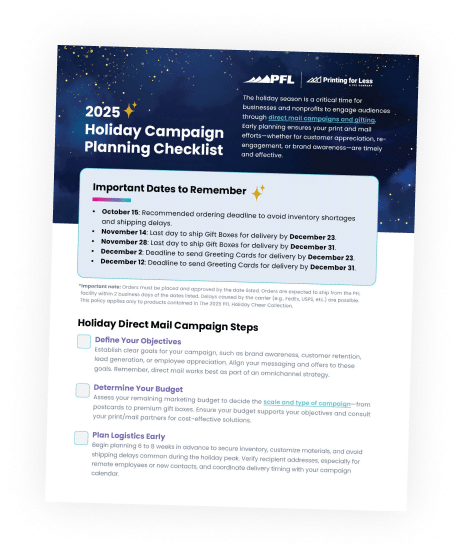
By the Printing for Less Team
Billions of pieces of mail are sent each year in the U.S., and much of it ends up in the trash. Why? Because most are unintelligent and meaningless—truly the definition of “junk mail.” It doesn’t have to be that way. Mail done effectively has the power to change lives for the better, whether it prompts a needed medical test, urges someone to apply for college, brings a holiday greeting, or simply gets some to open a checking account.
Historically, direct mail was expensive, poorly targeted, and time-consuming. And since direct mail has traditionally been siloed from the broader digital marketing efforts of an organization, marketers have lacked the ability to quantify its business value. Direct mail done well, however, has been an effective tool for marketers across industries for decades. In fact, research shows that more than half of consumers want direct mail from brands that interest them, and 70 percent say these physical engagements are more personal than online interactions. That’s why direct mail is once again popular, even in our ever-more-digital age.
Falls on Deaf Ears
It’s important to understand that the problem with direct mail is not the medium itself, but the message—and the way it’s often executed. Imagine listening to someone who can’t play the piano. It’s not the song that makes you want to poke out your ears, but the terrible noise made by the untalented “musician.” Similarly, direct mail, when done without creativity and insight, fails to resonate—it falls of deaf ears, if you will. However, when approached with innovation and a genuine understanding of the audience and the recipient’s needs, direct mail transforms into a powerful and catchy tune.
Successful direct mail campaigns captivate, engage, and inspire action. They tell compelling stories, offer valuable information, and create memorable experiences that digital channels often struggle to match. With the right strategy and execution, direct mail can establish a physical connection that feels personal and meaningful.
Those marketers who harness the full potential of direct mail understand that it’s not about flooding mailboxes with generic messages. Instead, it’s about crafting tailored communications that speak directly to the recipient’s needs and interests. When done right, direct mail can drive significant business results, proving that this traditional channel still holds immense value in the modern marketing landscape.
The ’Mail Moment’
In fact, recent findings by the U.S. Postal Service® reveal just how important mail is in the , daily lives of consumers. This research shows that every day, people throughout the country look forward to receiving their mail. The USPS reports that recipients open their mail with anticipation and give it their undivided attention. This ritual, they say, has been termed the “Mail Moment”—an important point for marketers to understand if they want to connect with consumers in an engaging and timely way.
Key Insights
Here are some of the key “Mail Moment” insights from the USPS study:
- 98 percent of consumers bring in their mail the day it’s delivered.
- Of these, 72 percent bring it in as soon as possible.
- 77 percent sort through their mail immediately.
- Consumers spend an average of 30 minutes reading their mail on any given occasion.
- They spend 45 minutes with magazines, 30 minutes with catalogs, and 25 minutes with direct mail.
This perfectly aligns with Printing for Less’s “Power of Moments” concept. We believe the right experience at the right time can advance connection to a brand. And it’s clear that, for businesses today, connecting to customers and prospects requires more than just digital expertise. Best-practice organizations weave together both physical and virtual experiences.
Over the last couple of decades, we’ve seen growing competition for eyeballs, clicks, and sales. Every day, consumers are bombarded with more and more marketing messages. Breaking through the attention-economy gridlock—and breaking the conventional marketing script—is critical. As the USPS research suggests, when businesses get personal across a product or service lifecycle, the results can prove transformative.
The report also indicates that, more than ever, consumers are predisposed to commercial messages in their mail. They cite that mail is usually sorted by the person in charge and that this person is often browsing for new consumption, managing the home, and/or overseeing finances. Of these “sorters”:
- 90 percent determine which mail is kept for review
- 81 percent review financial documents
- 84 percent are the principal grocery shoppers.
Clearly, mail is welcomed into people’s homes and plays a unique, personal, and important role in their daily lives.


















